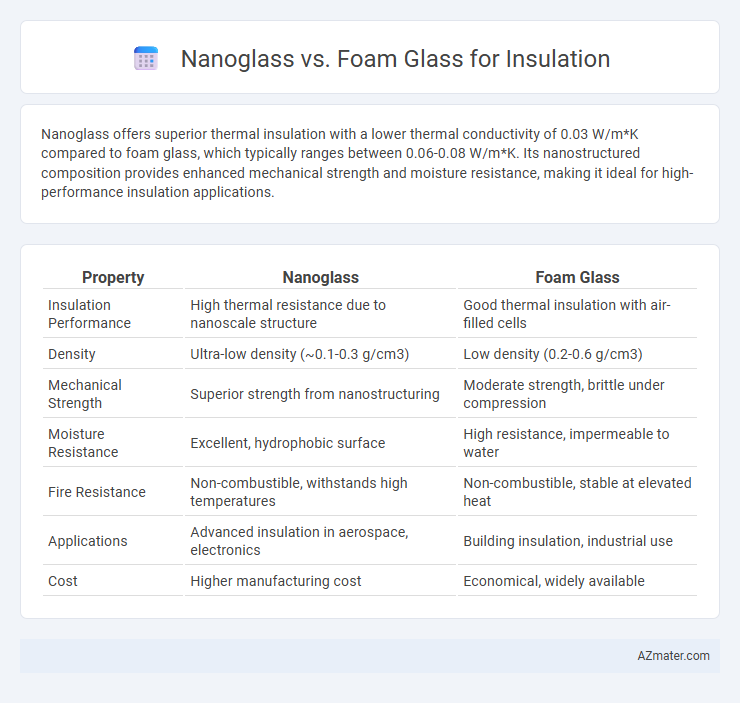Nanoglass offers superior thermal insulation with a lower thermal conductivity of 0.03 W/m*K compared to foam glass, which typically ranges between 0.06-0.08 W/m*K. Its nanostructured composition provides enhanced mechanical strength and moisture resistance, making it ideal for high-performance insulation applications.
Table of Comparison
| Property | Nanoglass | Foam Glass |
|---|---|---|
| Insulation Performance | High thermal resistance due to nanoscale structure | Good thermal insulation with air-filled cells |
| Density | Ultra-low density (~0.1-0.3 g/cm3) | Low density (0.2-0.6 g/cm3) |
| Mechanical Strength | Superior strength from nanostructuring | Moderate strength, brittle under compression |
| Moisture Resistance | Excellent, hydrophobic surface | High resistance, impermeable to water |
| Fire Resistance | Non-combustible, withstands high temperatures | Non-combustible, stable at elevated heat |
| Applications | Advanced insulation in aerospace, electronics | Building insulation, industrial use |
| Cost | Higher manufacturing cost | Economical, widely available |
Introduction to Nanoglass and Foam Glass
Nanoglass insulation utilizes nanoscale glass particles to provide superior thermal resistance and durability compared to traditional materials. Foam glass, made from crushed glass fused into a cellular structure, offers excellent insulation with high compressive strength and moisture resistance. Both materials serve as effective thermal insulators, but nanoglass stands out for its enhanced mechanical properties and lightweight nature.
Material Composition and Structure
Nanoglass insulation features a dense, non-porous glass matrix composed of nanoparticles that provides exceptional thermal resistance by minimizing heat transfer through conduction and convection. Foam glass consists of recycled glass with a cellular, closed-cell structure formed by gas bubbles trapped within the glass matrix, offering lightweight properties and effective thermal insulation with good compressive strength. The nanoscale particle size in nanoglass enhances surface area and reduces thermal conductivity compared to the larger pore structure of foam glass, making nanoglass superior for high-performance insulation applications.
Thermal Insulation Performance
Nanoglass offers superior thermal insulation performance compared to foam glass due to its ultrafine pore structure, which significantly reduces heat transfer and improves energy efficiency. Foam glass, while effective as an insulating material, has larger pores that allow higher thermal conductivity than nanoglass. The enhanced thermal resistance of nanoglass makes it ideal for applications requiring minimal heat loss and superior insulation properties.
Moisture and Chemical Resistance
Nanoglass insulation exhibits superior moisture resistance due to its dense, non-porous structure, preventing water absorption and minimizing mold growth. Foam glass also offers excellent chemical resistance, as its closed-cell formation resists most acids and alkalis, making it suitable for harsh environments. Both materials excel in durability, but Nanoglass often outperforms Foam glass in environments with high humidity or frequent chemical exposure.
Mechanical Strength and Durability
Nanoglass insulation exhibits superior mechanical strength due to its nanoscale structure, providing enhanced resistance to compressive forces compared to foam glass. Foam glass, while lightweight and effective for thermal insulation, tends to have lower durability under mechanical stress due to its porous cellular structure. The dense atomic arrangement in nanoglass materials offers improved longevity and resistance to structural degradation in harsh environments compared to foam glass insulation.
Fire and Heat Resistance
Nanoglass insulation offers superior fire resistance due to its non-combustible and high-temperature tolerance properties, effectively withstanding temperatures above 1000degC. Foam glass, while also fire-resistant and non-flammable, typically performs well up to temperatures around 600degC but may degrade at higher heat levels. The inherent thermal stability of nanoglass enhances its effectiveness in insulation applications requiring advanced fire and heat protection.
Environmental Impact and Sustainability
Nanoglass offers superior thermal insulation with a significantly lower embodied carbon footprint compared to foam glass, making it a more environmentally sustainable option. Foam glass, while recyclable and non-toxic, requires higher energy consumption during manufacturing due to its foaming process, resulting in greater greenhouse gas emissions. Both materials contribute to sustainability; however, nanoglass's durability and lower environmental impact make it preferable for eco-friendly construction.
Installation and Application Areas
Nanoglass insulation offers superior thermal performance with a lightweight, easy-to-handle structure ideal for tight or irregular spaces, streamlining installation in residential and commercial buildings. Foam glass provides excellent moisture resistance and compressive strength, making it suitable for underground, roofing, and industrial insulation applications where durability is critical. Both materials facilitate efficient energy saving, but nanoglass excels in versatility for interior walls, while foam glass is preferred for harsh environmental exposure and load-bearing conditions.
Cost Comparison and Economic Feasibility
Nanoglass offers superior insulation properties compared to foam glass, providing higher thermal resistance which can lead to long-term energy savings despite its initially higher cost. Foam glass, typically more affordable upfront, is favored for budget-conscious projects but may result in increased maintenance expenses over time due to lower durability. Evaluating the economic feasibility of both materials requires balancing initial investment, lifespan, and energy efficiency to determine the most cost-effective insulation solution for specific applications.
Choosing Between Nanoglass and Foam Glass: Key Factors
Choosing between Nanoglass and Foam Glass for insulation depends on factors like thermal conductivity, density, and moisture resistance. Nanoglass offers superior insulation performance with lower thermal conductivity values around 0.02 W/m*K, while Foam Glass provides excellent compressive strength and is highly resistant to water and fire. Cost considerations and specific application requirements such as weight constraints and environmental exposure also influence the optimal choice.

Infographic: Nanoglass vs Foam glass for Insulation
 azmater.com
azmater.com